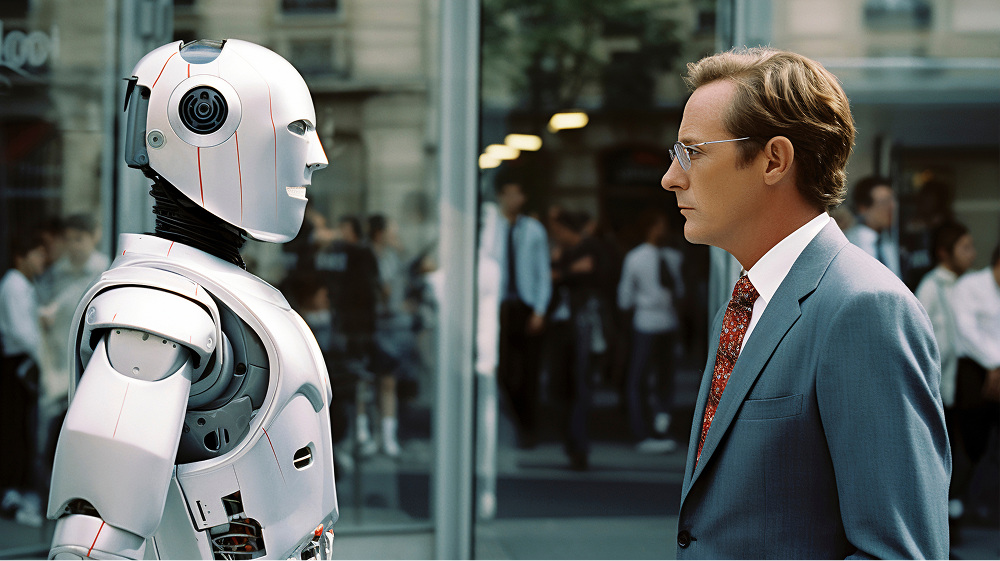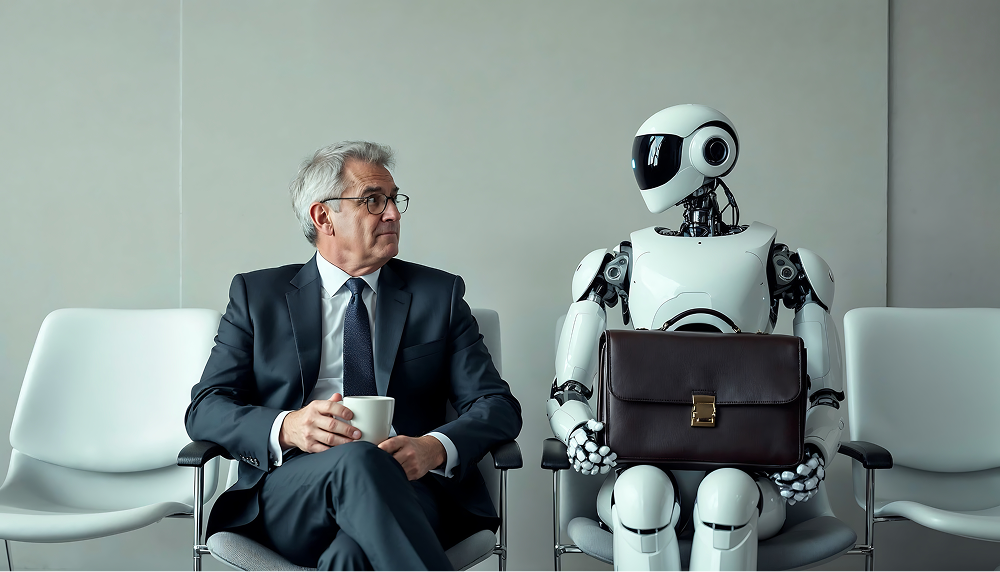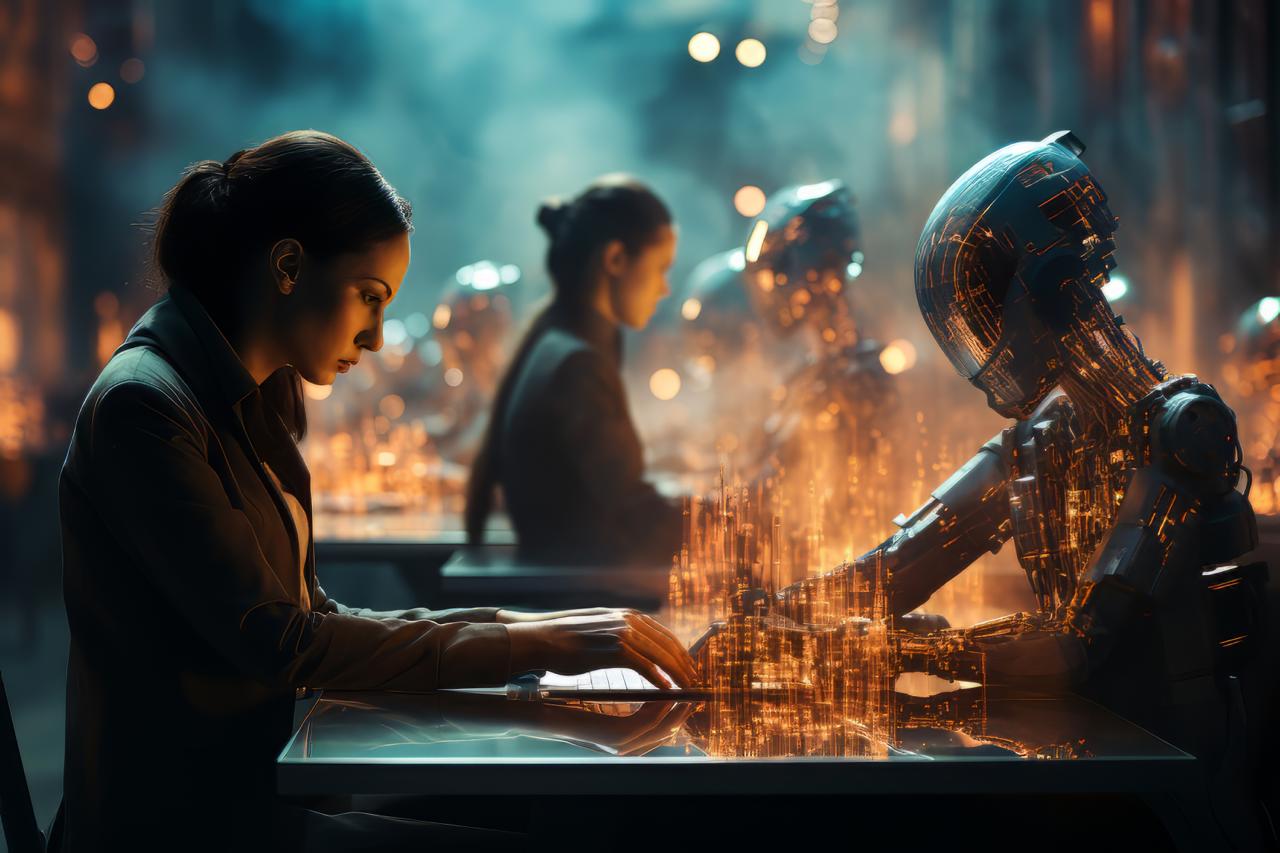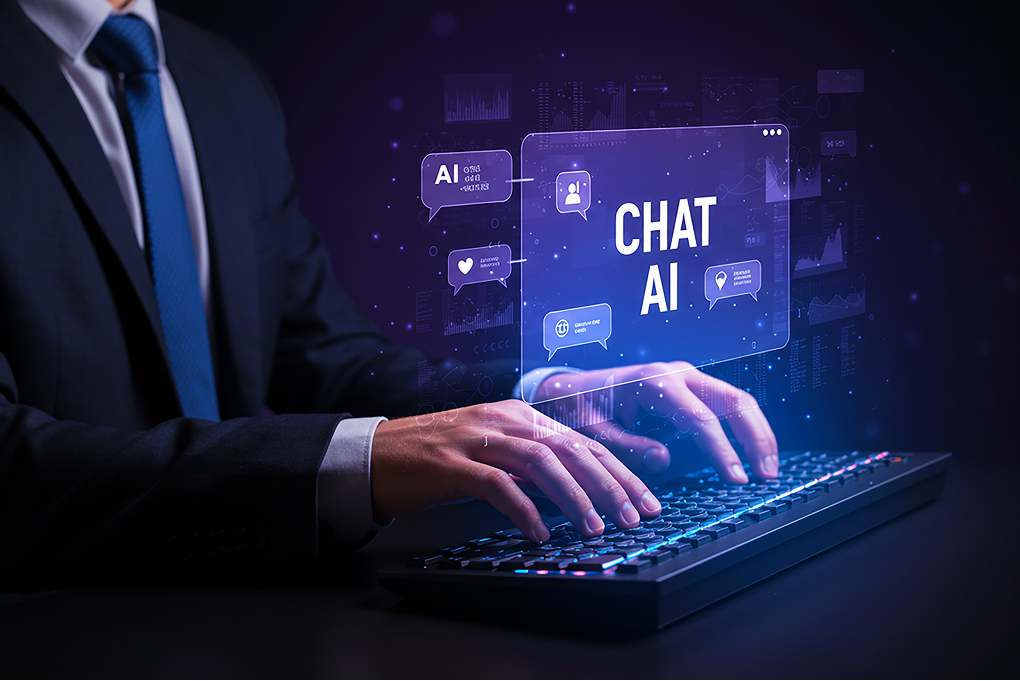Artificial intelligence is no longer just an idea from the future – today it is actively transforming the labour market. From software development and accounting to customer support and content generation, AI tools take over tasks previously done by office professionals.
In this post, we explore how AI impacts key industries, provide supporting data, and identify the professions most at risk of automation, from finance and IT to creative industries. We give specific examples where AI replaces human labour, explain the reasons for these changes and offer practical recommendations for specialists who want to remain in demand and effective in the market.
Whether you are concerned about the possible replacement of your AI role or you are looking for ways to adapt, this article presents practical approaches and strategies to stay competitive.
AI Isn’t Coming for Jobs – It’s Already Here
Artificial intelligence is already actively changing the labour market. More and more companies are implementing AI in all departments – from finance and IT to customer support and marketing. Recent studies show that more than 70% of organisations use artificial intelligence tools in at least one area of their activities, while many note an increase in productivity and a decrease in costs.
Professions related to repetitive tasks, data processing and even creative work, such as copywriting or programming, are being revised or completely replaced by AI systems. For example, chatbots are able to process thousands of client requests at the same time, and generative AI creates working code, articles or visuals in seconds.
The key to the relevance and competitiveness of the workforce in the AI era is to understand what roles are under threat and to develop adaptation strategies.
Why AI Could Make Work Better, Not Just Take It Away
Artificial intelligence does not just reduce jobs, it transforms the way we work, often improving them. When machines take on repetitive or labour-intensive tasks, employees have more time for analytical thinking, creativity and decision-making. In healthcare, AI accelerates data analysis and increases the accuracy of diagnosis by improving patient care. In education, intellectual systems customize lessons to different learning styles, helping teachers work more efficiently. Even in customer support and logistics, AI takes on routine tasks, allowing employees to focus on more complex and significant aspects of work.
Key Statistics About AI Replacing Jobs
Artificial intelligence is rapidly shifting the global workforce. While the pace varies by industry and region, the overall trend is clear: automation is reshaping how work gets done, and millions of jobs are affected.
According to recent estimates, up to 300 million jobs worldwide could be impacted by AI and automation. In the U.S. alone, studies suggest that 47% of roles may face disruption in the next decade. 14% of all workers globally could need to switch careers entirely by 2030 due to automation trends.
The risk isn’t evenly distributed. In advanced economies, around 60% of jobs face some level of automation exposure, while only 26% of jobs in lower-income countries are similarly affected. Education also plays a role—workers with less than a high school diploma are far less likely to hold positions highly exposed to AI.
Younger workers appear more concerned: those aged 18 to 24 are 129% more likely to worry about AI making their job obsolete than those over 65. Interestingly, 15% of U.S. employees say they’d be open to having an AI manager.
Although these figures show potential failures, they also open up new opportunities. Many professions will be transformed, not disappear, and those who start to adapt now will get the greatest benefits in the coming years

Why Human Talent Still Matters in the Age of AI
Despite the rise of AI tools in nearly every industry, many leaders are holding firm on one thing: people still matter. While AI can automate routine tasks and improve efficiency, it’s not replacing the value of real human insight. Executives in marketing, tech, and product development continue to emphasize that algorithms can’t replicate creativity, emotional intelligence, and critical thinking.
In fields where customer relationships, nuanced communication, or original thought are central, human involvement remains essential. Many companies that integrate AI are doing so to support—not replace—their teams. They use automation to streamline workloads while hiring people who can offer unique perspectives and judgment.
As the role of AI expands, it’s becoming clearer that success depends not just on what technology can do, but on how well humans use it. The real advantage lies in collaboration between human skills and machine capabilities—not one replacing the other.
The Impact of AI on Society and the Ethical Questions It Raises
Technology is already reshaping the way our world functions, and its influence continues to grow. Automation is reaching every corner — from government processes to healthcare, transportation, and even environmental management. These changes affect not just the economy, but the daily lives of people everywhere.
At the same time, pressing questions arise that cannot be ignored. Who controls the data? How can we ensure transparency in decisions made by machines? And what rights do people retain when technology impacts employment, law enforcement, or access to medical care? These are not abstract concerns — their effects are very real.
As AI tools become more powerful, the need for clear ethical standards and balanced regulation becomes more urgent. The challenge is finding ways to safeguard human rights while still fostering innovation. Creating systems that are not only smart but also fair, transparent, and accountable requires close collaboration between governments, technology companies, and professional communities.
What’s Stopping Teams from Embracing AI?
Even as AI adoption grows, many teams are still hesitant to go all in. One of the most common barriers is data privacy. Many organizations worry about how AI tools handle sensitive customer or internal information. Integration issues also slow things down—especially when new AI platforms don’t connect easily with legacy systems.
Training and onboarding take time and resources, and not every team has the bandwidth to learn new tools while managing day-to-day work. There’s also tool fatigue—many platforms promise similar features but lack interoperability, leading to confusion and inefficiency.
While job security concerns and internal resistance to change exist, they rank lower than technical and logistical challenges. Interestingly, a growing number of professionals report no significant barriers at all, showing that when the right infrastructure and support are in place, AI can be smoothly integrated into workflows.
Industries Most Vulnerable to AI Disruption
AI is not just automating individual tasks anymore—it’s streamlining entire workflows, reducing headcounts, and reshaping job expectations across industries. The following sectors are particularly at risk due to their reliance on routine, scalable, or easily automated functions.
Administrative and Office Support
Routine clerical work is among the first to be automated. AI handles data entry, scheduling, expense reports, and even email communication with high speed and accuracy. Tools built into productivity platforms now handle what used to require multiple full-time employees. Administrative assistants, payroll clerks, and office managers may find their roles reduced or redefined as companies adopt automation to cut costs and boost efficiency.
Customer Service
Chatbots and virtual assistants are increasingly becoming the first line of contact in the support service. They instantly respond to simple requests, give consistent answers and work around the clock without interruptions. Unlike a team of people, such systems are able to process thousands of interactions simultaneously, which makes them incredibly scalable. As a result, support centres can redistribute employees, leaving them to work with more complex cases that AI cannot yet cope with.
Manufacturing and Warehousing
Robots on assembly lines and AI tools for logistics have already become a familiar element of production and e-commerce. Machines take on tasks that require speed, accuracy and repeatability. Warehouses use robotic hands, sensors and automated vehicles to sort and move goods. These systems work without fatigue, reduce risks for employees and reduce the need for people in dangerous or heavy areas.
Retail and Hospitality
Self-service and automation are changing the frontal roles in the retail and hospitality industry. Self-service systems, AI inventory management tools and automated room service bots help companies reduce personnel costs. In hotels, AI assists with booking, check-in and concierge services, reducing the burden on reception staff. Despite the fact that some roles remain key, many initial positions are gradually replaced by technology or combined with other responsibilities, where the machine can take over the routine.
Media and Content Generation
Generative AI tools now produce written content, video scripts, designs, and images at a pace no human can match. Although they still require human editing and oversight, these systems are displacing entry-level copywriters, video editors, and designers. Marketing departments use AI to scale content production, test messaging, and personalize ads in real time—tasks that previously demanded a full creative team.
These shifts don’t necessarily mean total job loss. Instead, many roles are evolving. Workers who adapt, retrain, or move into roles that require creativity, emotional intelligence, or complex problem-solving will remain in demand. However, for industries centered on structured, repetitive tasks, the impact of AI is already here—and growing fast.
What Jobs Can Be Replaced by AI?
Artificial intelligence is rapidly changing the employment landscape. While AI is creating new roles, it’s also reshaping—and in many cases replacing—existing ones. From creative fields to logistics and finance, certain types of jobs are at higher risk due to AI’s ability to automate repetitive, rule-based, or data-driven tasks with speed, accuracy, and lower cost.
Below are some of the most vulnerable roles that may be reduced or transformed by AI in the coming years:
Customer Service Representatives
Chatbots and AI-based virtual agents are already processing a wide range of customer inquiries. They work around the clock, respond instantly and are able to have thousands of conversations at the same time. Companies actively use such platforms to solve standard issues, process returns or instruct users on services, which reduces the burden on call centre staff. As AI becomes better at understanding complex requests with the help of natural language processing technologies, the number of required human agents is gradually decreasing.
Car and Truck Drivers
Autonomous vehicle technologies are developing rapidly. The automation of long-haul trucks is especially promising, where the nature of driving is predictable and standardised. Companies test self-driving trucks and delivery vehicles, seeking to reduce labour costs and reduce the number of accidents related to fatigue or distraction of drivers. Although full automation is still under development, the first changes are already noticeable in the pilot programs and controlled delivery conditions.
Receptionists
AI-based systems, kiosks and virtual techniques are gradually replacing the traditional roles of administrators in offices, hotels and clinics. Such decisions can welcome visitors, make appointments, give instructions and even verify identity. For companies seeking to increase efficiency and reduce costs, replacing the administrator with a fully automated system often becomes a simple and profitable solution.
Accountants and Bookkeepers
AI takes on many accounting functions: account processing, payroll management, expense accounting and financial reporting. Previously, these tasks required time and human attention, but now the software makes them faster and more accurate. Nevertheless, specialists are still needed for strategic planning, complex analysis and tax consulting, but the need for initial positions is reduced.
Salespeople
In the field of transactional sales, especially in e-commerce, AI already assumes many functions of human teams. Recommendation systems, automated chatbots and consecutive letters guide customers through the sales funnel with almost no human intervention. In the B2B segment, AI helps to qualify leads, plan demonstrations and even suggests negotiation tactics based on customer behaviour. Nevertheless, human sellers remain important for high-budget products and building long-term relationships, while many positions on the frontline of sales are gradually disappearing.
Research and Analysis
AI is especially effective in processing large amounts of data, identifying trends and generating insights. Marketing analysts, business analysts and data researchers are increasingly using intelligent tools to speed up work and improve accuracy. In some companies, AI completely replaces the role of analysts, providing results faster and at a lower cost.
Factory and Warehouse Workers
Robots and AI systems in logistics today perform a wide range of physical tasks: sorting, packaging, loading and inventory management. They minimize errors, increase productivity and do not need rest or bonuses. For example, companies like Amazon are actively integrating AI in their warehouses, and the trend is spreading around the world. According to the forecasts of the World Economic Forum, by 2030 manual labour in production may decrease by 30%.
Insurance Underwriting
AI already knows how to process applications, assess risks and form a pricing policy. Predictive analytics allows platforms to make decisions that were previously made by underwriters. Automation reduces processing time and personnel costs, and with the improvement of models, the roles of traditional underwriters may become rare.
Computer Programmers
Although it may seem counterintuitive, some programming tasks are at risk of automation. AI tools like GitHub Copilot can generate code snippets, write functions, and even complete entire modules. Entry-level or routine coding jobs, particularly those involving repetitive tasks or legacy maintenance, are likely to decline. That said, skilled developers are still essential to design, supervise, and validate what AI builds.
Paralegals
Tasks that were previously performed by paralegals research of legislation, analysis of contracts and verification of documents are now often performed much faster and more accurately with the help of AI. Legal platforms based on artificial intelligence are able to scan thousands of documents in seconds, highlight key terms and even predict possible outcomes of cases. Human supervision is still necessary, but law firms are gradually reducing their dependence on support staff.
Financial Traders
High-frequency trading already relies on algorithms that analyse the market and make transactions in microseconds. Artificial intelligence goes further, using historical data and current market conditions to predict likely results. With the increasing accuracy of these systems, the need for traditional traders decreases, especially in large investment companies.
Travel Advisors
Travelling is becoming more and more automated today. Artificial intelligence-based platforms can personalise routes, compare prices and offer recommendations taking into account user behaviour and preferences. Although some travellers still prefer to work with an agent for complex trips, most use self-service through AI tools. As virtual assistants become smarter, the need for human travel counselors gradually decreases.
Content Writers
AI text writing tools can create articles, product descriptions and posts for social networks in seconds. Although they lack deep creativity and strong editorial judgement, they do an excellent job with voluminous and template content. This puts pressure on junior content specialists and copywriters: companies use AI for drafts, leaving people only the final editing or work on complex materials.
Graphic Designers
AI platforms for design allow you to create logos, advertising materials and visual elements without special skills. Businesses that used to hire freelancers or full-time designers are increasingly turning to automated tools to save time and resources. At the same time, designers remain necessary for complex campaigns and branding, while simpler tasks are gradually transferred to machines.
Data Entry Clerks
Processing structured data is one of the most easily automated tasks. AI checks, stores and processes information faster than humans, which leads to a rapid reduction in these roles in banks, insurance and government agencies. According to McKinsey estimates, by the end of the decade, up to 38% of such jobs can be automated.
Telemarketers
AI chatbots and automated calling systems are already replacing telemarketers. These tools can handle cold calls, respond to questions, and even adjust their messaging based on customer responses. Unlike humans, AI doesn’t experience burnout and can run campaigns at a much lower cost. Telemarketing as a profession is shrinking fast.
Proofreaders
AI-based grammar and style checkers, such as Grammarly or language models embedded in writing platforms, now handle much of the work previously done by human proofreaders. They correct grammar, punctuation, and tone errors in real time. While editorial judgment is still needed for high-stakes content, routine proofreading is largely automated.
Delivery Drivers
Autonomous delivery vehicles, drones, and AI-optimized routing software are gaining ground. Companies are testing driverless trucks for long-haul freight and drones for last-mile deliveries. Though regulation and public trust still limit full-scale deployment, the path toward automating delivery jobs is clear and progressing.
Security Guards
AI-powered surveillance systems, facial recognition, and motion detection technologies can now monitor premises continuously. These systems reduce human error, respond faster to threats, and are already replacing guard roles in commercial and residential settings. While some positions may remain for physical intervention, AI is taking over the monitoring and reporting functions.
Pharmacists
AI tools are increasingly taking on routine tasks in pharmaceuticals – filling in prescriptions, checking dosages and inventory management. Such systems help to reduce the number of errors and increase efficiency, especially with large volumes of labour. At the same time, pharmacists remain indispensable for counselling and control, and machines increasingly perform everyday operations.

10 Major Companies Quietly Replacing Jobs with AI Technology
The integration of artificial intelligence into business processes has gradually moved from experiments to real implementation. Although companies often declare “support and empower teams”, behind the scenes many roles are either restructured or completely disappear. Below are ten well-known companies that have already implemented AI to replace or redistribute human tasks – through layoffs or retraining of personnel.
1. MSN

Back in 2020, MSN reduced dozens of contract journalists who formed content for the main page of the site. They were replaced by automated systems that select and generate news. Although the cost reduction was officially cited as the reason, it was one of the first examples of replacing the AI editorial office.
2. Google

Despite the fact that we are not talking directly about AI, numerous layoffs in 2024 strongly influenced the sales and support departments of advertising – an area where AI is actively used to improve efficiency. Automation is gradually replacing traditional roles, even if it is not advertised.
3. Microsoft

In 2024, the company reduced about 6,000 employees, including many engineers. After Satya Nadella’s statement that about 30% of the code is now generated by AI, the connection between layoffs and automation is difficult to deny.
4. Ikea

The Swedish retailer is gradually replacing the call centre with a Billie chatbot. Instead of mass layoffs, the company trains employees in new roles, such as interior consultants. This is a rare example when AI changes, not destroys jobs.
5. BlueFocus

The Chinese marketing agency has stopped cooperation with designers and content authors, switching to generative AI tools. This decision followed the introduction of key AI platforms, which clearly accelerated the automation of processes.
6. Salesforce

In 2024, the company reduced about 700 positions. There was no direct link to the replacement of AI, but the growth of investments in automation and new technologies clearly demonstrates the company’s movement towards AI.
7. Duolingo

The company did not dismiss employees directly, but did not extend contracts for about 10% of the external labour force. This is due to the strengthening of the role of AI in the translation and generation of content, reflecting the strategy of Duolingo as an organisation “AI-first”.
8. Turnitin

Although the company is focussed on AI, it reduced its staff in 2023 and continues to reduce the number of staff. AI tools are becoming so effective that fewer experienced employees are required in order to reduce the total labour force to 20%.
9. Klarna

The new artificial intelligence tool has taken over the tasks of customer service previously performed by about 700 agents. Although the company has outsourced these functions, the effect is the same: AI has become a more economical alternative for large teams.
10. Best Buy

After large-scale layoffs in 2023, the company launched an initiative to implement AI in partnership with Google Cloud. The direct connection with the reductions has not been officially confirmed, but the sequence of events indicates the key role of AI in team restructuring.
These companies reflect a broader trend: the introduction of AI is not just the addition of new tools, but the redistribution of the person who does the work. For many companies, this means quietly replacing people with machines that do not need vacations, training or medical care.
How Many Jobs Will Be Lost to AI by 2030?
Estimates suggest that artificial intelligence could have a significant impact on the global workforce by 2030. One of the more widely cited projections comes from Goldman Sachs, which indicates that AI could replace the equivalent of 300 million full-time jobs worldwide. This estimate includes roles that may not disappear completely but will be significantly altered through automation.
In the U.S. and Europe, roughly two-thirds of jobs are considered exposed to some level of AI automation. For about a quarter of those, AI could take over the tasks entirely. The most vulnerable are white-collar roles that involve routine decision-making, data analysis, or content generation—many of which are held by college-educated workers earning up to $80,000 per year.
The McKinsey Global Institute projects that by 2030, at least 14% of the global workforce may need to transition to new occupations due to AI, automation, and other digital technologies. Some industries, like manufacturing and customer service, are expected to be hit harder than others.
However, the conversation about AI cannot be limited to the loss of jobs. Experts emphasise that automation simultaneously creates new opportunities. Some professions did not exist a few years ago, and technology itself can become a driver of economic growth – it is estimated that AI can increase global GDP by about 7%. For companies and employees, the key task today is to manage this transition properly: invest in retraining, adapt to new processes and rethink how value is created in the organisation.
Conclusion
AI is changing the labour market faster than many predicted. From content production and customer service to logistics and finance, automation is already transforming key processes in most industries. Some professions will gradually disappear, others will change, and others will appear in completely new areas.
The key task for specialists and companies is to manage this transformation: timely retraining, development of interdisciplinary competencies and implementation of sustainability strategies in the context of automation. Those who can determine in advance the skills in demand and invest in them will have a competitive advantage in the economy, where AI becomes the basic infrastructure.
If you are not sure how to adapt to the transformation of the labour market, our team is ready to help. We provide targeted expertise – from planning career transitions to advanced training programs and assessing the impact of technology on specific industries. Timely actions help reduce risks and provide the support needed to stay relevant in the age of AI.




